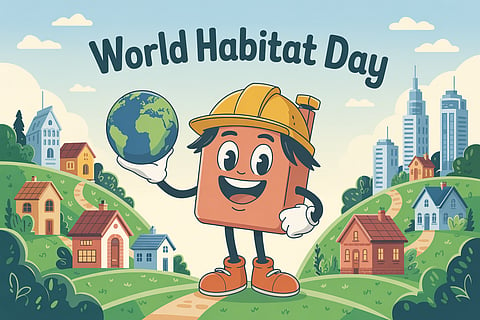

Imagine waking up to flooded streets, no electricity, and schools shut because of heavy rain. Or picture a scorching heatwave so strong that stepping outside feels like walking into an oven. These moments show how suddenly a crisis can strike a city — and how prepared we need to be to face it. That’s what World Habitat Day 2025 is all about.
Observed on the first Monday of October every year, World Habitat Day reminds us that our homes and neighbourhoods are part of a much bigger system — our habitat. The United Nations first started it in 1985 to highlight that safe shelter is a basic human right and that the way we build our cities affects how well we live.
This year’s theme, “Urban Crisis Response,” focuses on how cities can prepare for and recover from emergencies — whether they’re caused by floods, fires, pandemics, or even climate change.
More than half the people on Earth already live in cities, and by 2050, that number will rise to nearly seven in ten. Cities are full of opportunities — schools, jobs, hospitals, and parks — but they also face challenges like traffic, pollution, and overcrowding. When a crisis hits, these problems can grow quickly. A sudden downpour can flood narrow lanes; a heatwave can cause power cuts; an earthquake can expose weak buildings. That’s why World Habitat Day asks an important question: are our cities ready for the next big shock?
Being “ready” doesn’t just mean reacting fast — it means planning smart. Stronger houses, cleaner drainage systems, more trees, and reliable public transport can all make a huge difference. So can early-warning systems that alert people before storms or floods. During the Covid-19 pandemic, many cities showed that technology could help — from tracking cases to delivering food and medical aid.
In India, efforts to build safer and smarter habitats are already under way. The Smart Cities Mission uses technology to manage traffic, waste, and water more efficiently. The Pradhan Mantri Awas Yojana works to provide affordable housing so that everyone has a safe place to live. The National Disaster Management Authority trains communities and local governments to respond quickly when emergencies occur. Cities like Chennai and Surat have developed early flood-warning systems to protect residents during heavy monsoons.
But creating resilient habitats isn’t just the government’s job. Every citizen, including students, has a role to play. When people take care of their surroundings — by keeping streets clean, planting trees, saving water, and helping neighbours in need — they make their city stronger. Even small actions, like not littering or switching off lights when leaving a room, can reduce strain on city systems.
Climate change has made this mission even more urgent. Rising temperatures are causing longer heatwaves, melting glaciers are leading to unpredictable floods, and storms are becoming stronger than before. Since cities produce over 70 per cent of global carbon emissions, they are both part of the problem and part of the solution. Greener spaces, cycle tracks, rooftop gardens, and renewable energy can help reduce the ents like you do?
World Habitat Day is a perfect time to imagine the city of the future — one that stays strong during crises and kind to those who live in it. You could start by asking: what would make your neighbourhood safer? Maybe more trees to cool the air, better footpaths, or waste bins on every corner? You could draw posters, build models of eco-friendly cities, or hold classroom debates on what makes a good habitat. Every idea counts, because the cities of tomorrow will be built by the young people of today.